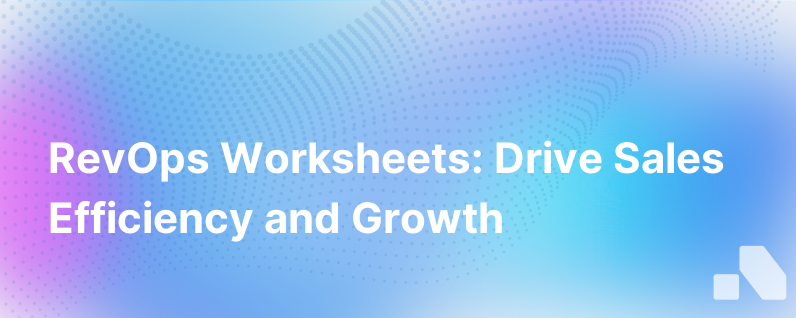From The Revenue Operations Council Revops Worksheets
Published on November 21, 2023 by David Zhang
When it comes to streamlining business functions for B2B sales in the ever-evolving landscape of startups and enterprises, 'revenue operations' or 'RevOps' stands as a burgeoning concept that more organizations are warming up to. RevOps is much more than a buzzword; it embodies a strategic, holistic approach to aligning sales, marketing, and customer success operations across the full customer lifecycle. This concept fosters a unified approach to maximize an organization’s revenue potential.
Among the tools and frameworks utilized by businesses to implement RevOps efficiently, worksheets and structured documents provided by thought leaders in the space such as the Revenue Operations Council play a pivotal role. In this article, we will dissect these RevOps worksheets, understand their purpose, and discover how effective they can be when integrated into your business strategy.
Understanding RevOps Worksheets
At the core, RevOps worksheets are documents designed to help align various departments of an organization in the service of increasing revenue. Often containing a series of templated formats, these worksheets guide users through the process of setting up the RevOps function, analyzing workflows, spotting inefficiencies, and creating actionable steps towards optimization. They are closely tied to metrics and measurable outcomes, making them invaluable for decision-makers looking to fortify their operational strategies.
Here’s a breakdown of key RevOps worksheets and how they are utilized:
1. Organizational Alignment Worksheet
The Organizational Alignment Worksheet aims to create alignment across departments. It helps teams understand each other's goals, processes, and pain points. By filling out this worksheet, team leaders can map dependencies, uncover overlaps in tools or efforts, and create a roadmap for integrating operations that prop up the organization's revenue cycle.
2. Process Optimization Worksheet
The Process Optimization Worksheet is a tool designed to identify redundancies, streamline workflows, and outline a clearer path to customer acquisition and retention. This often involves mapping current processes, identifying bottlenecks or touchpoints that could be improved, and proposing changes to enhance efficiency and reduce friction.
3. Technology Stack Audit Worksheet
With the multitude of software solutions available today, ensuring your technology stack is not just robust, but also cohesive, is essential. The Technology Stack Audit Worksheet allows businesses to take stock of their current tools, assess their relevance to the unified revenue goal, and make determinations about new technologies that could fill gaps or replace outdated systems.
4. Data and Reporting Standardization Worksheet
Data is the fuel that powers decision-making in RevOps. The Data and Reporting Standardization Worksheet serves to establish common data definitions across teams, decide on critical success metrics, and create reporting templates that provide clear visibility and insights. This process promotes data-driven decision-making and ensures that everyone is interpreting KPIs consistently.
5. Communication Rhythm Setup Worksheet
Effective communication is the backbone of cross-functional alignment. This worksheet helps establish a communication plan that details who needs to know what and when. By setting up regular meetings, updates, and reports, this worksheet ensures that all teams are in sync and aware of progress and challenges.
Implementation and Best Practices
RevOps isn’t simply about worksheets and documentation – It's about the insights and actions these tools foster. Here are some best practices for implementing RevOps worksheets into your business operations:
- Start with cross-departmental buy-in: Before you dive into worksheets, ensure that all departments understand the importance of RevOps. This buy-in is critical for successful implementation.
- Customize worksheets to your business model: The templates provided by thought leaders are great starting points, but for the best results, tailor them to your organization’s specific needs and dynamics.
- Regularly revisit and update: To keep up with the dynamic business environment, these worksheets should not be a one-time activity but a continuous process.
- Leverage technology for efficiency: Technology solutions like Aomni can automate many aspects of the worksheets, from data aggregation to process analytics, speeding up the RevOps implementation.
The Role of AI in RevOps and Worksheets
The integration of AI technologies, like the solutions offered by Aomni, is revolutionizing how RevOps worksheets are used and managed. AI can process vast amounts of data to provide real-time insights, predict outcomes, and recommend actions. By incorporating AI into the RevOps framework, businesses can significantly reduce the time spent on manual data entry and analysis, and instead focus on strategy and implementations that directly influence revenue growth.
Conclusion
Structured RevOps worksheets can be an invaluable asset for any organization looking to harmonize and streamline its sales, marketing, and customer support operations. When used effectively, these worksheets offer a pragmatic approach to eradicating operational silos, enhancing process efficiencies, and driving revenue growth.
By employing these worksheets and abiding by the best practices outlined above, leaders can foster a culture of continuous improvement and revenue-centric operations management. And with innovative tools like those provided by Aomni, the future of RevOps looks to be seamless, strategic, and amplified by the power of AI.